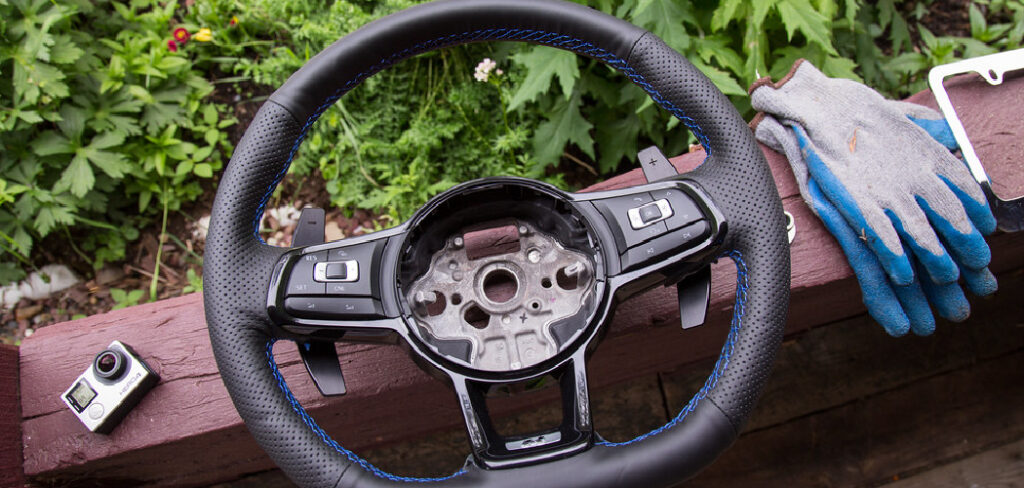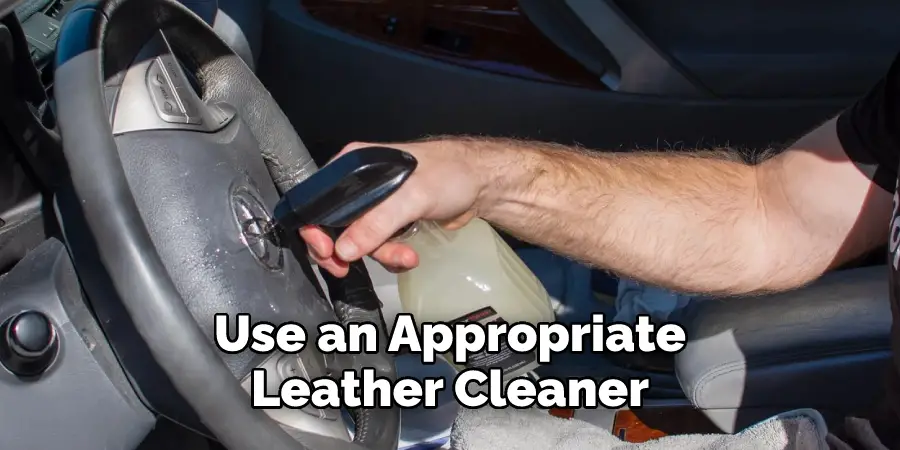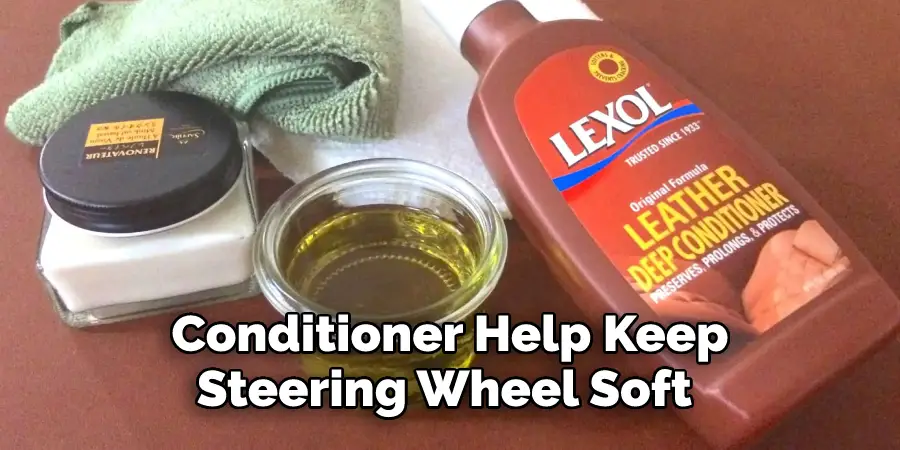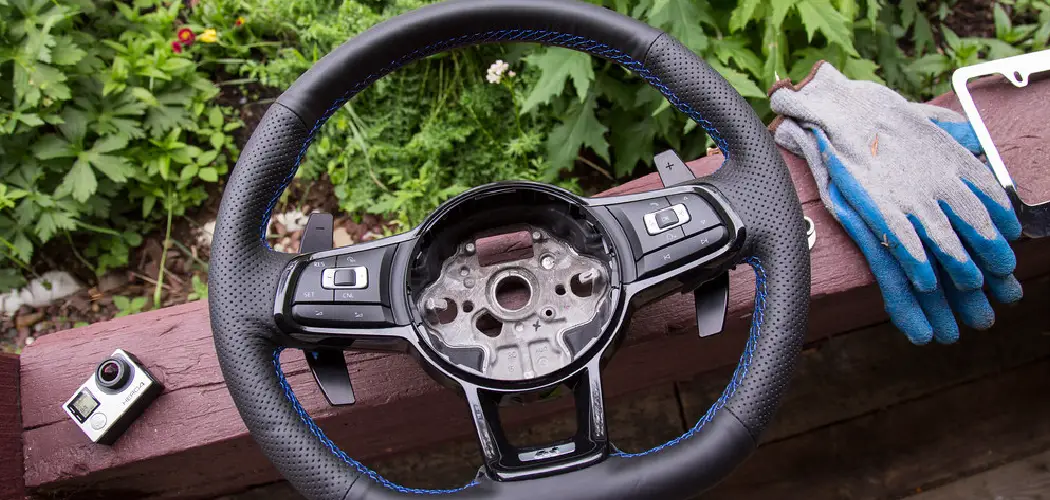Leather steering wheels are often found in luxury cars and can provide a luxurious feel to your driving experience. However, without proper cleaning and disinfection, the leather on these steering wheels can become discolored, stained, or cracked due to dirt buildup or general wear and tear. Disinfecting your leather steering wheel is important to maintaining it in good condition and ensuring its longevity.

The advantage of cleaning and disinfecting leather steering wheels is that it prevents the spread of germs, bacteria, and viruses. Disinfecting a leather steering wheel also helps to maintain its appearance and protect it from wear and tear.
When properly cleaned and disinfected, a leather steering wheel can last for many years without showing signs of age or wear. In this blog post, You will learn how to disinfect the leather steering wheel.
Step-by-step Instructions for How to Disinfect Leather Steering Wheel
Step 1: Inspect the Leather Steering Wheel
Before you start any cleaning process, it’s important to inspect the steering wheel for any dirt or grime. You may need a soft cloth to gently scrub away any debris.
Step 2: Vacuum the Leather Steering Wheel
Use a vacuum cleaner with a brush attachment to clean off as much dirt and dust as possible from the leather surface. Make sure to vacuum the steering wheel’s top and underside for a thorough clean. Make your own cleaning solution by mixing a few drops of mild soap with warm water. Dip the soft cloth into the soapy water and wring out any excess liquid before gently wiping down the steering wheel.
Step 3: Rinse With Water
After cleaning, rinse off the steering wheel with a damp cloth or sponge. This will help remove any soap residue. Once you have rinsed the steering wheel, make sure to dry it off completely with a soft cloth. This will help prevent water spots and ensure that no streaks remain.
Step 4: Disinfect Leather Steering Wheel
Use an appropriate leather cleaner or disinfecting solution to disinfect the steering wheel thoroughly. Ensure to read the instructions on the product label before use and follow all safety precautions when handling a product with chemicals. After you have finished disinfecting your leather steering wheel, you can protect it from future wear and tear by applying a leather conditioner or protector.

Step 5: Let Conditioner Dry
Allow the conditioner to fully dry and absorb into the leather before using it. Use a clean, soft cloth to wipe off any excess conditioner from the surface of the wheel. This will help prevent any build-up that could damage the leather in the long run.
Step 6: Inspect the Finished Product
Once you have finished cleaning and conditioning your steering wheel, inspect it to ensure all dirt and grime have been removed. If there are still marks or stains, repeat Steps 2-9 until the entire surface is cleaned and conditioned.
Following these steps, you can effectively clean and disinfect your leather steering wheel to keep it looking new.
Tips for How to Disinfect Leather Steering Wheel
- Before starting the cleaning process, wear gloves and protective eyewear to protect your hands and eyes from harmful chemical substances.
- Wipe down the steering wheel with a damp cloth or microfiber cloth to remove dirt, dust, and debris.
- Spray leather cleaner onto the steering wheel and use a soft cloth to gently scrub away any remaining dirt, dust, and debris.
- Finish by wiping down the steering wheel with a clean damp cloth until all of the leather cleaners are removed from the surface.
- If there are any difficult areas that require more attention, use a small brush to scrub those areas.
- Check the manufacturer’s instructions for any specific cleaning advice, and make sure to follow them accordingly.
- Make sure you use a pH-neutral leather cleaner or solution, as anything too harsh can permanently damage the steering wheel’s surface.
- Avoid using chemical solutions such as bleach or ammonia on the steering wheel, as these can cause severe damage to the leather.

Following the above tips can help you to properly disinfect and clean your leather steering wheel, keeping it in top condition for many years.
How Often Should You Disinfect Your Leather Steering Wheel?
It’s important to keep your leather steering wheel clean and disinfected on a regular basis. How often you need to clean and disinfect your leather steering wheel depends largely on how much it is used.
If you drive frequently, then you should clean and disinfect it at least once a month, as dirt, sweat, oil, and other contaminants can build up quickly. If you drive only occasionally, then once every two to three months should be sufficient.
In any case, giving your leather steering wheel a quick wipe down with disinfectant wipes or cleaning spray after each drive is always a good idea to ensure the cleanliness and hygiene of your car’s interior. Additionally, it’s important to clean and disinfect more often if anyone in your home is sick to help prevent the spread of germs.
Finally, ensure you’re using the correct cleaning products when disinfecting a leather steering wheel. As leather is a delicate material, it’s important to avoid harsh or abrasive cleaners, which can cause damage or discoloration. Instead, use a leather-safe cleaner specifically designed for cleaning leather surfaces.
How Can You Prevent Future Germs From Building Up on Your Leather Steering Wheel?
One of the best ways to prevent future germs from building up on your leather steering wheel is to clean it frequently. Wipe down your steering wheel often with a damp cloth dipped in soapy water, then dry it off with a soft towel. This will help reduce the number of bacteria that may start to build up over time.
If you want to go the extra mile, you can use a leather conditioner after cleaning your steering wheel with soap and water. A quality leather conditioner will help keep your steering wheel soft and provide some germ-fighting protection.

It’s also important to keep your hands clean before touching the steering wheel by regularly washing them with warm soapy water. Finally, choosing a car with leather steering wheel covers is wise. These covers can help keep your hands and the steering wheel clean by limiting contact with the actual leather of the steering wheel.
How Can You Cleanse and Protect Your Leather Steering Wheel From Dirt and Other Contaminants?
Keeping your car’s interior clean and free from dirt, dust, germs, and other contaminants is important. Leather steering wheels are especially vulnerable to these contaminants due to the porous nature of leather. Fortunately, with a few simple steps, you can easily disinfect and protect your leather wheel from dirt, bacteria, mold, and mildew.
The first step is to remove any dirt or debris from the surface of the leather wheel. Use a wet, soft cloth to gently wipe away any dirt and dust. Take care not to scrub too hard as it can damage delicate leather fibers. After cleaning, allow the wheel to air dry thoroughly before proceeding with further steps.
Once your wheel is clean, it’s time to disinfect. You can use a mild solution of soap or all-purpose cleaner and warm water to kill off any germs that may be present on the leather surface.
Use a soft cloth dampened with this solution and gently wipe down the entire surface of the wheel. Again, take care not to scrub too hard as it can damage the leather fibers. Once complete, allow the wheel to air dry thoroughly before applying any protectants.
How Do You Maintain the Quality of Your Leather Steering Wheel Over Time?
After you disinfect your leather steering wheel, it is important to maintain its quality over time. This can be done through regular cleaning and conditioning. To clean the leather, use a soft cloth that has been slightly dampened with lukewarm water. Gently wipe away dirt or other debris from the surface of the leather.
Once all dirt has been removed, use a leather cleaner and conditioner to keep the surface soft and supple. Make sure to follow the product instructions closely when applying the cleaner and conditioner to ensure that you are not over-applying or damaging the leather in any way.
In addition to cleaning and conditioning, protecting your leather steering wheel from the elements is important. If your vehicle is stored outside in a garage or carport, it is best to cover the leather with a breathable cover when not in use. This will help keep dirt and dust off of it that can damage the surface over time.

If you drive frequently and are exposed to harsh UV rays, you can also protect the leather with a UV protectant spray. These products are designed to provide extra protection from sun damage and help keep your leather looking new for years to come.
Conclusion
The main disadvantage of the disinfectant leather steering wheel is its cost. Disinfecting your leather steering wheel can be expensive if a professional needs to do the job, and even more so if you choose to use specialty products for cleaning and protecting your leather. Additionally, some of these products may contain harsh chemicals which could damage your leather steering wheel if not used correctly.
In conclusion, disinfecting your leather steering wheel is important to keeping your car clean and hygienic. Disinfecting a leather steering wheel involves cleaning the surface with soap, water, and a soft cloth, allowing it to dry fully before applying a leather conditioner to help keep it in good condition over time.
It is also important to use the appropriate products for disinfecting, as some may damage leather. I hope this article has been beneficial for learning how to disinfect leather steering wheel. Make Sure the precautionary measures are followed chronologically.

